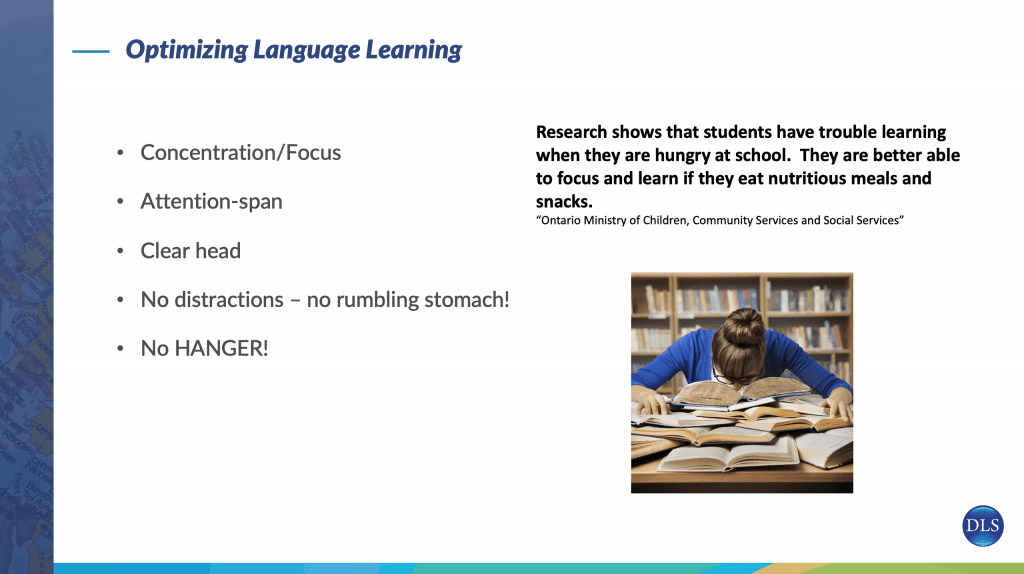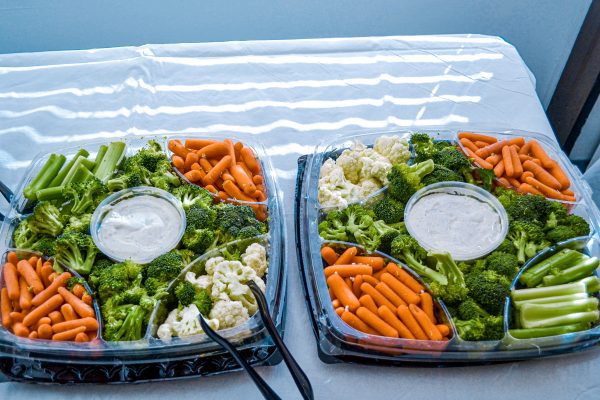Watch our Nutrition for Language Learning Wellness Webinar here!
Learning a new language has been shown to be incredibly beneficial for brain health, and finally feeling like you have mastered a language can be a terrific confidence booster. It is, however, also true that learning new skills only becomes more difficult as we get older; as such, any advantage we can give ourselves is one we should explore to its fullest!
We all know that proper nutrition is essential for peak physical performance, and most of us are aware of basic nutritional guidelines: less processed food, avoid added sugars as much as possible, eat your vegetables, and so on. But what you may NOT realize is the profound impact your diet can have on your ability to learn – and retain – new information, such as a new language. We are what we eat, after all, and our brains can only function as effectively as our diet permits.
So what does this mean in practice? How can we tweak our diets to optimize our brainpower? Must we eat a diet that consists solely of kale, chia seeds, and quinoa? Must we eschew ALL comfort foods, all snacks, and desserts that aren’t 100% healthy?

While foods such as kale and quinoa can certainly be a part of a healthy diet, the key to discovering the best language-learner diet for you is finding that balance, that cadence of eating, and those ingredients that work for you. When considering what your breakfast, lunch, dinner, and snacks should look like, it’s important to be true to yourself. At the end of the day, as with all habits, if your diet truly makes you miserable, it won’t be sustainable no matter how healthy it is. So ask yourself a few questions to get started:
What are my favorite foods?
Create a list of the top 10 contenders. Be honest with yourself about which can be kept as part of a healthier diet. If one of your top 10 foods is pizza, for example, you don’t have to completely avoid this fan-favorite; there are many ways to make pizza healthier AND tasty – a thin, whole wheat crust, simple toppings such as fresh mozzarella and basil, limiting your portion size, etc. If, on the other hand, your #1 favorite food is bacon or french fries, it may be time to relegate those to the “occasional treat” list.
What foods can I absolutely NOT work with?
If you have tried kale every which way and still just can’t stomach it, then don’t. There are no specific foods that you MUST eat in order to be healthy, so find those that work for you and ditch those you dislike.
What food makes me feel awful?
Chances are, this list includes fried food and sugary desserts – again, add to that “occasional treat” list!
What eating schedule works best for me?
If you really just can’t eat in the morning, then don’t. But do concentrate on small shifts in a schedule so you aren’t eating the bulk of your calories late in the day. That said, there’s no absolute schedule you must follow, so if you aren’t a snacker, 2-3 meals/day is fine. If you’re more of a grazer, then spread your calories out over 4-5 smaller meals.
Once you’ve had “The Talk” with yourself about your preferences and habits, it’s time to start thinking about the foods that have been shown to benefit the learning brain by increasing attention span, improving concentration and focus, by allowing for a clear head and less fatigue, and by prolonging those blood sugar crashes that lead to the HANGER that can really wreak havoc with trying to learn a new skill or language.
Instead of relying on the SAD Diet – that’s right, the Standard American Diet is quite appropriately called the SAD Diet – a diet heavy on processed foods, added sugars, fried foods, saturated fat, the works – find ways to incorporate foods from this list into your diet:
REAL Fruit Juice (if you must drink juice)
Look for added sugars when shopping – as your brain relies on glucose for energy, but sugar-laden juices won’t do you any favors.
Eggs
Scramble them, poach them, boil them…eggs are an easy way to get those pesky B vitamins, and they’ve been shown to improve cognition and memory.
Avocados
This trendsetter is not only delicious but also full of good fats, which will help keep you fuller for longer and can help reduce bad cholesterol.
Blueberries, Raspberries, Strawberries…
All berries contain powerful antioxidants that can reduce inflammation in your body and brain.
Fish
Salmon, cod, sardines, trout, etc. Fish is one of the best natural sources of Omega-3 fatty acids, which are critical in maintaining brain health.
Nuts
One of the best snacks available with lots of vitamin E, a memory booster, and the good fats that keep you full without weighing you down.
Dark chocolate
That’s right, you CAN satisfy your sweet tooth AND be healthy, just look for chocolate that’s 60-70% cacao.
Popcorn
Preferably not the movie theater butter-laden kind, air-popped popcorn is a whole grain and one of the best sources of dietary fiber that won’t break your calorie bank.
Beans
There are more than 70 varieties of these protein and fiber powerhouses. Add them to burritos, salads, stews, over rice…the options are endless.
Spinach
Yes, it’s not as tasty perhaps as a blueberry muffin, but spinach is a fantastic source of multiple vitamins. It is the best vegetable source of vitamin K and iron, both crucial for keeping your energy up and your body functioning properly!
It can be overwhelming to implement changes to your diet. To make it easier, take a few minutes to write out a menu plan for the week. Then, make sure you are stocked up on the essentials that will enable you to make healthy choices instead of reaching for the processed snacks when hunger strikes! Learning a new language is hard enough in the best of circumstances, so let’s all focus on making the diet choices that will give our brains that boost!
For more DLS, check out other blogs and visit us on Facebook, LinkedIn, Instagram, or Twitter!
By Kate Marden




